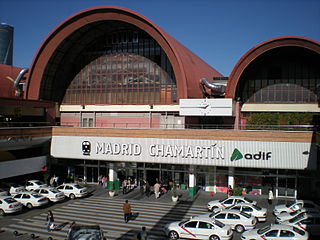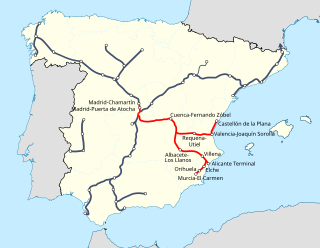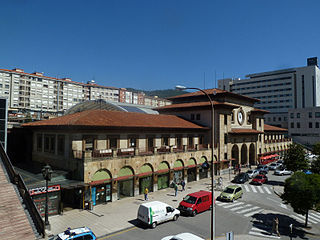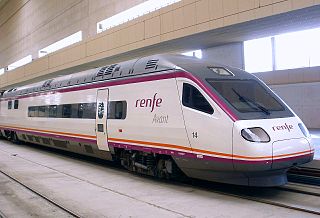
Transport in Spain is characterised by a network of roads, railways, trams, air routes, and ports. Its geographic location makes it an important link between Europe, Africa, and the Americas. Major forms of transit generally radiate from the capital, Madrid, located in the centre of the country, to link with the capitals of the autonomous communities.

Renfe, officially Renfe-Operadora, is Spain's national state-owned railway company.

Rail transport in Spain operates on four rail gauges and services are operated by a variety of private and public operators. Total railway length in 2020 was 15,489 km. The Spanish high-speed rail network is the longest HSR network in Europe with 3,966 km and the second longest in the world, after China's.

Alta Velocidad Española (AVE) is a high-speed rail service operated by Renfe, the Spanish State railway company.

Cercanías Madrid is the commuter rail service that serves Madrid, the capital of Spain, and its metropolitan area. It is operated by Cercanías Renfe, the commuter rail division of Renfe, the former monopoly of rail services in Spain. Its total length is 370 km.

The Estación de Madrid-Chamartín Clara Campoamor or Madrid Chamartín is the second major railway station in Madrid, Spain. Located on the northern side of the city, it was built between 1970 and 1975, but more work was carried on into the early 1980s. It then superseded Atocha station, which is located just south of the city centre. However, as the AVE network expanded with a hub at Atocha, Chamartin again became Madrid's second station by passenger volume.

High-speed railways in Spain have been in operation since 1992 when the first line was opened connecting the cities of Madrid, Córdoba and Seville. Unlike the rest of the Iberian broad gauge network, the Spanish High-speed network mainly uses standard gauge. This permits direct connections to outside Spain through the link to the French network at the Perthus Tunnel. High-speed trains run on a network of high-speed rail track owned and managed by ADIF, where the dominant service is AVE while other high speed services such as Avant, Alvia, Avlo, Euromed, Ouigo España and Iryo, as well as mid-speed (Altaria) services also operate.

Barcelona Sants is the main railway station in Barcelona, owned by Adif, the railway infrastructure agency of Spain. It has become the most important transport hub of the city - being the centre of Rodalies de Catalunya including Barcelona suburban railway services and regional services, as well as the main inter-city station for national and international destinations. The station is named after Sants, the neighbourhood of Barcelona in which it is located. New parts of the station have recently been remodeled to accommodate the Spanish high-speed train AVE in the city, which started serving the city on 20 February 2008. There is also an adjacent international bus station bearing the same name, and a link to the Sants Estació metro station that serves the railway station.

Cercanías Murcia/Alicante is a commuter rail service (cercanías) in the provinces of Alicante and Murcia. The line connects Alicante and Murcia with San Vicente del Raspeig, Elche, Orihuela, Totana, Lorca, and Águilas. It runs through 200 km of railways with a total of 26 stations.

The Renfe Class 130 or S-130 is a high-speed dual-gauge, dual-voltage trainset consisting of 11 Talgo VII tilting coaches and two power cars, used on Alvia and Euromed services. The class have been nicknamed patitos (ducklings), due to the shape of the train nose.

The Madrid–Asturias high-speed rail line connects the city of Madrid with the autonomous community of Asturias and was inaugurated on 29 November 2023. The line is built to standard gauge and gauge changers are provided at strategic points to allow interchange with older Spanish railways which were built to Iberian gauge.

ADIF is a Spanish state-owned railway infrastructure manager. This state owned company reports to the Ministry of Transport and Sustainable Mobility. ADIF is charged with the management of most of Spain's railway infrastructure, that is the track, signaling and stations. It was formed in 2005 in response to European Union requirements to separate the natural monopoly of infrastructure management from the competitive operations of running train services. It is the legal successor of Renfe, Feve, and GIF.

The Madrid–Levante high-speed network is a network of high-speed rail lines that connects Madrid with the Mediterranean coast of the Levante Region, specifically with Castilla-La Mancha, the Valencian Community and the Murcia Region autonomous communities.
Traditionally, the gauge of the national railway in Spain, now managed by Adif, is 1,668 mm, known as Iberian gauge. This gauge was decided upon by a Parliamentary committee, after a report known as the Informe Subercase in 1844. Spain has 11,791 km of track with this gauge.

Madrid is served by highly developed transport infrastructure. Road, rail and air links are vital to maintain the economic position of Madrid as a leading centre of employment, enterprise, trade and tourism, providing effective connections with not only other parts of the region, but also the rest of Spain and Europe as a whole. Three quarters of a million people commute into the city to work, and these and other local travellers have available a high-capacity metropolitan road network and a well-used public transport system based on the Metro, the Cercanías local railways, and a dense network of bus routes.

Oviedo railway station is the main station in the Spanish city of Oviedo, capital of the province of Asturias. It opened in 1874 and was reconstructed after the Spanish Civil War.

The Renfe Class 447 is a class of electric multiple unit trains built by CAF, Alstom, Siemens, ABB, and Adtranz for Renfe Cercanías, Spain's commuter railway networks. The first units entered service in 1993.

Murcia del Carmen railway station is the main railway station in the Spanish city of Murcia.

Cartagena railway station Cartagena is a railway terminal station located in the Spanish municipality of Cartagena, in the region of Murcia. It has medium and long distance services operated by Renfe. The Art Nouveau building was built between 1903, when the foundation work began, and 1908, when the central or main building was finished. The design of the building was the joint work of architect Emilio Antón Hernández along with engineers José Cebada Ruiz and José Moreno Rodríguez, all of them being directed and supervised by the engineer Ramón Peironcely.

Avant is a high-speed, medium-distance passenger transport rail service, operated in Spain by the Spanish public company Renfe. Avant services circulate at a maximum speed of 250 km/h (160 mph), compared to the 300 km/h (190 mph) maximum speed of the AVE service. Their routes usually cover different provinces within the same autonomous community or between neighboring ones. Regional services at conventional speed are called Renfe Media Distancia.




















